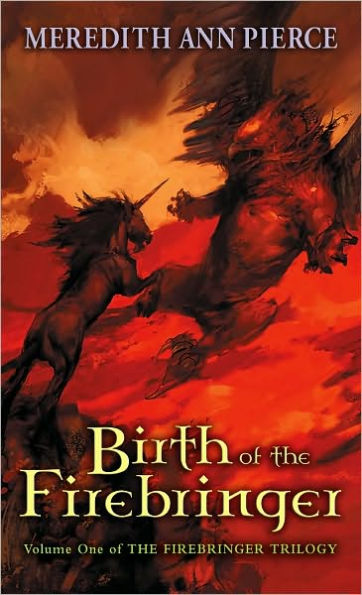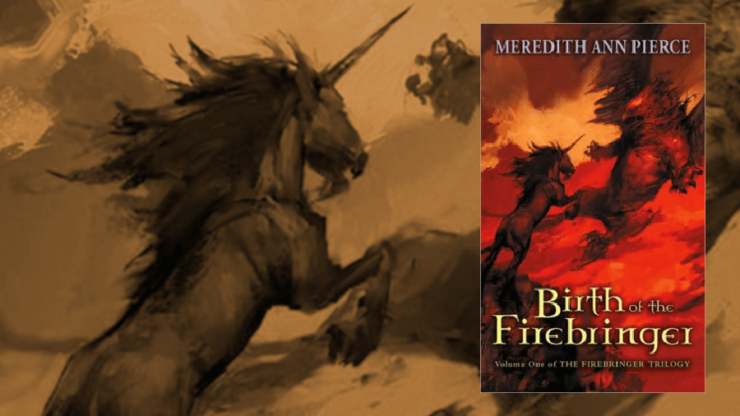I’ve gone on record as not being a fan of talking-animal fantasies, but I make exceptions. The Silver Brumby is one, and there’s The Horse and His Boy, which for all its problems still has some lovely bits. And now, having missed Meredith Ann Pierce’s Birth of the Firebringer when it was first published, I’m adding another to my very short list of talking-animal stories that I actually enjoyed.
The book is not technically about horses, but close enough. It’s about unicorns. It’s a hero’s journey, with a mysterious prophecy and an ancient evil and a prince’s son who won’t play by the rules.
Our hero is callow young Jan, whose father the prince overprotects him, in his estimation, and won’t allow him to go on pilgrimage to be initiated as a young adult. Jan is constantly getting into scrapes; his “games” range from irresponsible to deadly dangerous.
Jan’s world is small, his knowledge not much wider. His people live in country they’ve seized from the gryphons, after being driven out of their own lands by an invasion of wyverns—who were, in turn, exiled from their homeland. The Pilgrimage is a long journey back to the unicorns’ ancestral territory, a vision quest to the lake, which their ancestors poisoned in an attempt to stop the wyverns. It didn’t work: The wyverns won. But wyverns hibernate; unicorns make their journey right before spring, when it’s more or less safe.
Jan manages to earn a place among this year’s initiates, after a game that gets him in serious trouble with his father but turns into a bit of heroism as he fights off a pair of gryphons who have attempted to kill the prince. He tries hard to act like a responsible young adult, though being Jan, he doesn’t stay out of trouble for long.
On his journey he learns the truth behind the legend of Renegade unicorns who have left or been exiled from the Circle. He discovers that the faunlike pans are not quite as bestial as unicorn stories make them. And he does battle with the evil queen of the wyverns, and sees the fulfillment of the prophecy of the Firebringer, the great unicorn who will restore the lake to purity and become the ruler of his people.
It’s classic fantasy in structure and theme, with mythical beasts, and no humans at all—though it’s made clear that they do exist in this world. (They will in fact play a key role in the second volume of the trilogy.) Horses also exist, as a cautionary tale among the unicorns. If a unicorn abandons the Circle or is cast out, the story goes, he’ll lose his horn and his beard and his cloven hooves and turn into a mere and mortal, earthbound horse. Jan learns the truth about that, too.
What makes this work for me is a combination of lovely prose and thoughtful worldbuilding, especially around the physical and psychological nature of the unicorns. (Also the in-depth consideration of colonialism and the movement of peoples in response to ecological and political pressure, but this is SFF Equines, so we’ll focus on the horse-adjacent aspects.) Unicorns are drawn in colors that remind me of a combination of My Little Pony and special-edition Breyer models, but they act and to a degree think a lot like real-world horses—with the addition of horns.
And that’s why it works. The body language and the overall attitudes are horselike: flattening ears and pawing the ground as a show of temper, for example, or playing colt-games with rearing and shoving, or kicking at attackers from behind. But Pierce has given thought to the fact that unicorns have horns. They spar with them, they sharpen them on their hooves (and are strictly forbidden to do so before their initiation into adulthood, for safety as much as for ritual purposes), they use them as weapons.
Buy the Book


Birth of the Firebringer
Unicorns eat like horses, too. They graze at length as horses have to, and forage for feeds other than grass. They’re dependent on clean water and plenty of it. They know nothing of fire, because cooked food is not a thing a herbivore would need, and they don’t need it for warmth, with their hair coats—though they retreat to caves in severe weather.
Unicorn coats are a bit of worldbuilding that says, to me, “This person knows horses.” Jan is in winter coat through much of the novel, and we get to see how it ripples in the wind and how it becomes much less efficient when soaking wet. We also, at the end, see him shed it in spring, and the way he does it is straight-on realistic. (Spoiler: A horse’s winter coat may not be the same color as his summer coat. He may also shed out to a different color one year than he did the year before, especially if he’s quite young. And if he’s in foal coat, there’s a certain shade that indicates he’s going to be a particular color when he sheds. A horse person who knows this will be clued in right away to one of the big reveals at the end.)
Even the talking-animal part makes sense to me. It’s built into the world, how the goddess Alma gave speech to all the peoples but the pans—which is ironic because pans are the closest to human-like of any species Jan is aware of.
But Jan learns that story isn’t quite true, either, and in the process, we maybe learn that speech here doesn’t necessarily mean human spoken language. It could be body language, signs and gestures, sounds that humans would hear as whinnies or screeches or growls, or even, for that matter, mental speech. Pans communicate, too, just not in the way the rest of the creatures in this world do. And pans have fire, which is crucial to the unfolding of the plot.
All in all, for those looking to see how to extrapolate horses into mythical equinoids, this is a good example. It does its homework, it understands the basic animal, and it tells a solid story in a lovely style while it’s at it.
Judith Tarr is a lifelong horse person. She supports her habit by writing works of fantasy and science fiction as well as historical novels, many of which have been published as ebooks by Book View Cafe. She’s even written a primer for writers who want to write about horses: Writing Horses: The Fine Art of Getting It Right. Her most recent short novel, Dragons in the Earth, features a herd of magical horses, and her space opera, Forgotten Suns, features both terrestrial horses and an alien horselike species (and space whales!). She lives near Tucson, Arizona with a herd of Lipizzans, a clowder of cats, and a blue-eyed dog.










